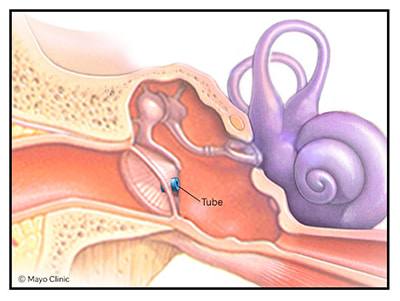-
Does my child need ear tubes?

Middle ear infections are caused by bacteria or a virus that infects fluid that has builds up in the middle ear. These infections often happen when a child has a cold, allergy or upper respiratory illness. Ear infections can be painful and cause difficulty sleeping or hearing. Unfortunately, they also are one of the most common infections for children.
Inserting tubes in the ear is a treatment for chronic ear infections. Here are answers to questions about this procedure:
What are ear tubes?
Ear tubes are tiny, hollow cylinders made of soft plastic. They are placed in the eardrums and allow air to circulate between the outer and middle ear.
Are ear tubes common in children?
Myringotomy, the procedure to insert ear tubes, is the most common surgical procedure performed on children. Kids have a higher risk of runny noses and ear infections because their eustachian tubes are shorter and narrower than those of adults. Because the eustachian tubes in children aren't as developed, they can become inflamed or irritated more easily. This leads to ear infections. Ear tubes can help relieve the pressure that builds up during an infection or altogether prevent infection.
While the procedure is more common in children, inserting ear tubes also can help adults who experience recurring ear infections.
How do I know if my child needs ear tubes?
Ear tubes likely will help kids who have chronic ear infections. This means those who have had at least three ear infections within six months or four infections within one year, all with persistent middle ear fluid. If a child has had fluid buildup in the ears for at least three months, the health care team may recommend a hearing test to show if a child has a loss of hearing
For adults, the most common symptoms that may improve with ear tubes are muffled hearing and ear pressure. These symptoms can cause a sense of imbalance or dizziness — like rocking in a boat — if there is fluid buildup in one ear but not the other. In these cases, placing an ear tube can help the person regain balance.
How are ear tubes placed?
The process of placing ear tubes is simple and quick. The surgeon makes a small incision in the eardrum to suction out fluid from the middle ear. Then a tiny tube is inserted in the opening to ventilate the ear and prevent fluid buildup in the future. Patients experience little to no pain.

For adults, a surgeon can place tubes during a clinic appointment, using topical medication to numb the eardrum. There is minimal recovery necessary for adults. They can go back to work or school the same day.
Young kids may not be able to sit still during the procedure, so ear tubes are inserted in an operating room. They receive anesthesia to make them fall asleep. The entire procedure can last less than one minute. I joke with parents that it takes longer to put children to sleep than to put in the ear tube. I encourage parents to keep kids home for the rest of the day after surgery, but they can return to school or day care the next day.
Do ear tubes provide relief?
Yes. For many patients, relief from the pain and discomfort of a middle ear infection is almost immediate. Once the fluid is removed and the pressure decreases, patients usually feel and hear better immediately. Any dizziness also improves right away. After the procedure, children aren't in constant pain so most behave better, aren't as clingy and sleep well.
Do ear tubes fall out?
Yes, ear tubes are made to fall out on their own. Over time, the eardrum heals, pushing the tube into the ear canal. Ear wax moves it to the outer ear. Most tubes remain in children's ears for about one year. For adults, it's about six months.
Children may need tubes placed again if they start having ear infections after the original tubes fall out. If a second set of tubes is needed, your child's health care team may recommend removing the adenoid glands as well. These are two small pads of tissue found on the back of the nose. The eustachian tubes drain the ears on either side of the adenoids. If the adenoids are enlarged, they can block drainage and cause ear infections.
Talk with your child's health care team if you're concerned about chronic ear infections and think ear tubes may help. Or talk with your health care team if you are experiencing muffled hearing or dizziness.
Pao Vang, M.D., is an otolaryngologist in Eau Claire and Rice Lake, Wisconsin.
This article originally posted on the Mayo Clinic Health System blog.
Related Articles







